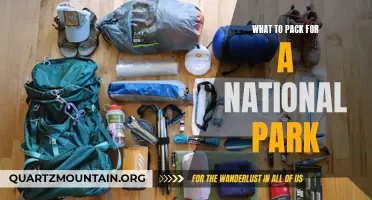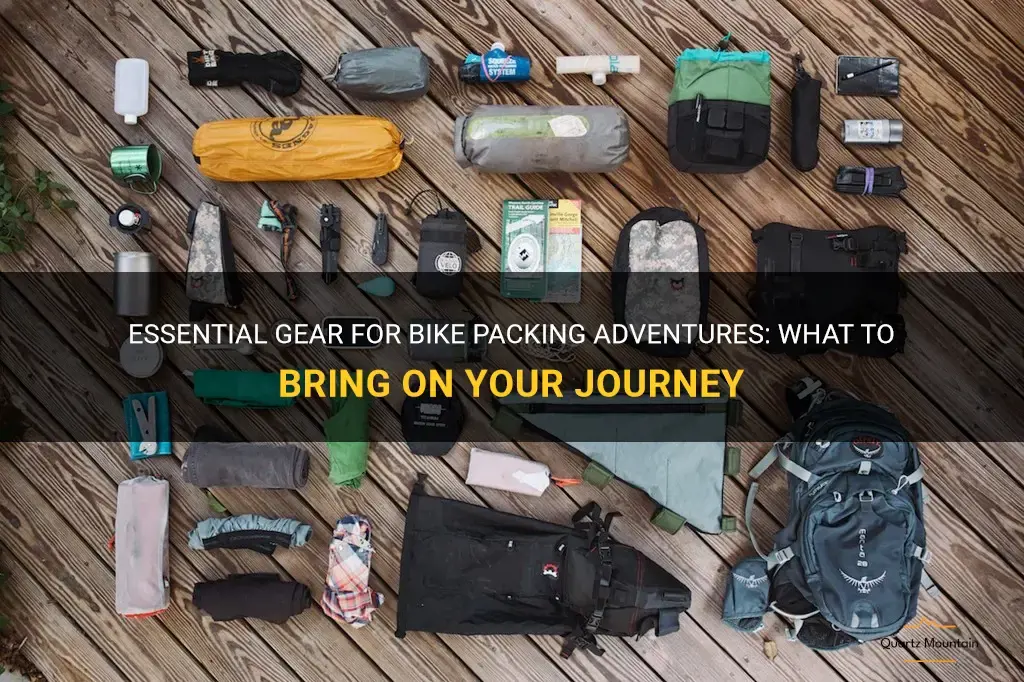
Are you an adventure seeker looking to explore the great outdoors on your trusty bicycle? Bike packing is the perfect way to experience the thrill of the open road while immersing yourself in nature. However, to ensure a safe and enjoyable journey, it is essential to have the right gear. From lightweight camping equipment to durable bike accessories, we have compiled a comprehensive list of essentials that will make your bike packing adventure unforgettable. Buckle up and get ready to hit the road!
What You'll Learn
- What essential gear should I bring when bike packing?
- How do I choose the right size and type of backpack for bike packing?
- What type of sleeping bag and tent should I bring for bike packing?
- Are there any specific clothing items I should pack for a bike packing trip?
- What are some important tools and repair items to bring for bike packing?

What essential gear should I bring when bike packing?
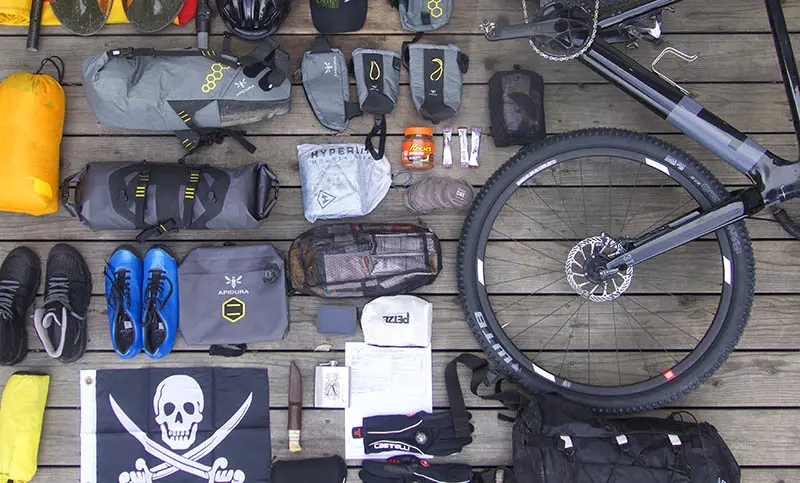
Bike packing is a popular adventure activity that involves traveling long distances on a bike while carrying all of your gear with you. Whether you are embarking on a multi-day tour or a weekend camping trip, it is important to have the right gear to ensure a safe and enjoyable experience. Here are some essential items that you should pack when going bike packing.
- Bike: The first and most obvious item you will need is a reliable bike. Choose a bike that is suitable for the type of terrain you will be riding on, whether it is pavement, gravel, or off-road trails. Make sure your bike is properly fitted to your body and in good working condition before setting off on your trip.
- Bike bags: Bike bags are an essential component of bike packing as they allow you to carry all of your gear while maintaining stability and balance on the bike. There are several types of bike bags available including frame bags, handlebar bags, seat bags, and panniers. Choose bags that are durable, waterproof, and can securely hold your gear.
- Tent: A lightweight and compact tent is essential for overnight bike packing trips. Look for a tent that is easy to set up and take down, with good ventilation and protection from rain and insects. Consider the number of people that will be using the tent and the amount of space you will need for your gear.
- Sleeping bag and sleeping pad: A good night's sleep is crucial when out on a bike packing adventure. Invest in a high-quality sleeping bag that is suitable for the climate you will be traveling in. Look for a sleeping bag that is lightweight, compact, and has a temperature rating that matches the expected conditions. Additionally, bringing a sleeping pad will provide extra comfort and insulation from the ground.
- Cooking gear: Depending on the length of your trip and the availability of food along your route, you may need to bring cooking gear with you. A lightweight camping stove, fuel canister, and a cookset with pots and utensils are essential for preparing meals on the go. Choose gear that is compact and lightweight to minimize added weight to your bike.
- Repair kit: It is important to be prepared for any mechanical issues that may arise during your bike packing trip. Bring a basic repair kit that includes a bike pump, spare inner tubes, tire levers, a multi-tool, and a patch kit. Familiarize yourself with how to use these tools and practice basic bike maintenance skills before setting off on your trip.
- First aid kit: Accidents can happen, especially when biking in remote areas. A well-stocked first aid kit is essential for treating minor injuries and providing immediate care until professional help can be obtained. Include bandages, antiseptic ointment, pain relievers, and any necessary personal medications in your kit.
- Clothing: Choose clothing that is comfortable, wicks away sweat, and provides protection from the elements. Pack a mix of lightweight layers that can be easily added or removed depending on the temperature. Consider the expected weather conditions during your trip and pack accordingly, including rain gear and warm clothing for colder climates.
- Water and hydration: Staying properly hydrated is important when engaging in physical activities such as bike packing. Bring enough water bottles or a hydration pack to ensure you have access to clean drinking water throughout your trip. Additionally, consider bringing a water filtration system or water purification tablets in case you need to find water from natural sources.
- Navigation tools: Depending on the type of terrain you will be riding on, you may need some form of navigation tools to help you navigate your route. This could include a GPS device, a map, a compass, or a smartphone with a navigation app. Make sure you are familiar with how to use your chosen navigation tools before setting off on your trip.
In summary, bike packing requires careful planning and packing of essential gear to ensure a successful adventure. By bringing the right items, you can enjoy the freedom of the open road while having all the necessary equipment to stay safe and comfortable during your trip. Remember to always practice Leave No Trace principles and respect the environment you are traveling through. Happy bike packing!
Top Essentials to Pack for a Caribbean Cruise in December
You may want to see also

How do I choose the right size and type of backpack for bike packing?
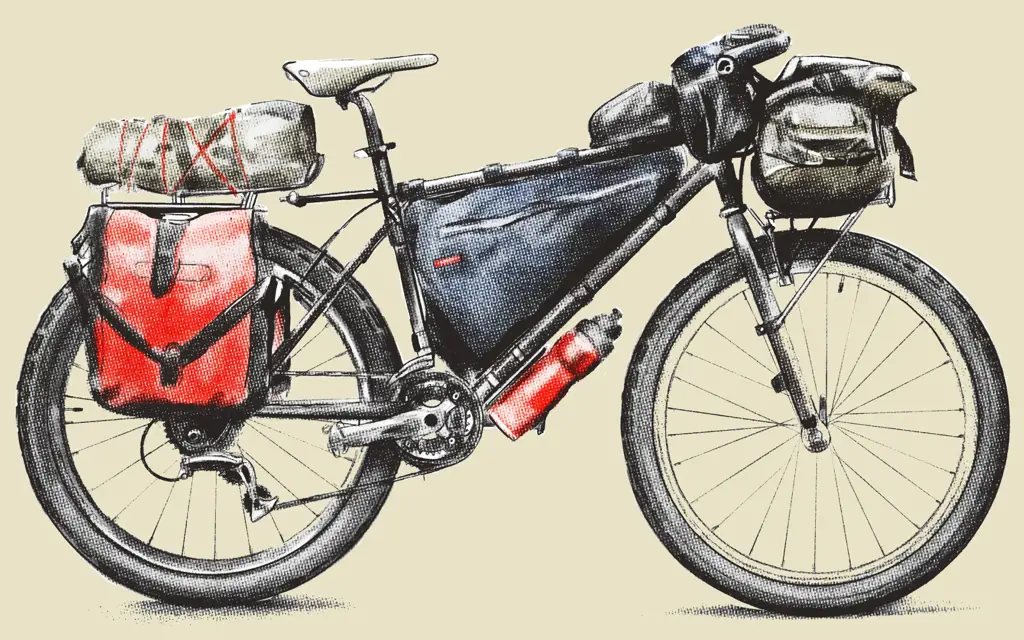
Choosing the right size and type of backpack for bikepacking is crucial for a successful and comfortable trip. The backpack you choose should be able to carry all the necessary gear while also distributing the weight effectively. In this article, we will discuss the steps to choosing the right size and type of backpack for bikepacking, as well as provide some examples and expert advice.
Step 1: Assess Your Needs
Before choosing a backpack, it is important to assess your needs and determine how much gear you will need to carry. Consider the length of your trip, the terrain you will be riding on, and the weather conditions you may encounter. This will help you decide the size of the backpack you require.
Step 2: Consider Backpack Capacity
Backpacks come in various sizes, typically measured in terms of liters. For bikepacking, a capacity of around 20-30 liters is usually sufficient for most riders. However, if you are embarking on a longer trip or need to carry more gear, a larger capacity may be necessary. Keep in mind that a larger backpack may add weight and impact your balance while riding.
Step 3: Focus on Weight Distribution
When choosing a backpack, it is essential to consider how the weight will be distributed on your back. Look for a backpack with a well-padded hip belt and adjustable shoulder straps. The hip belt should rest comfortably on your hips, transferring the weight from your shoulders to your lower body. Additionally, the shoulder straps should be easily adjustable to ensure a proper fit.
Step 4: Evaluate Features
Consider the various features that a backpack offers. Look for compartments and pockets that will allow you to organize your gear efficiently. Features such as hydration bladder compatibility, external attachment points for gear, and compression straps to control the volume of your load can also be beneficial.
Step 5: Fit and Try Before Buying
Before making a purchase, it is recommended to try on the backpack and adjust the straps accordingly. Walk around with the loaded backpack to ensure it feels comfortable and stable on your back. Different brands and models may have variations in fit, so it is crucial to find one that suits your body shape and riding style.
Example 1: For a short weekend trip with moderate weather conditions, a 20-liter backpack may be sufficient. Look for a backpack with a hydration bladder pocket, a few internal compartments for organizing gear, and external attachment points for carrying a sleeping bag or tent.
Example 2: If you are embarking on a more extended bikepacking adventure, such as a multi-day trip or a bikepacking race, a larger backpack with a capacity of 30+ liters would be more suitable. Look for a backpack with additional features like a rain cover, extra accessory pockets, and a ventilated back panel for enhanced airflow.
Expert Advice: According to experienced bikepackers, it is advisable to keep the weight of your loaded backpack as light as possible. Choose lightweight and compact gear, prioritize essential items, and consider the overall packing strategy to optimize weight distribution. Remember, a lighter backpack will enhance your comfort and agility on the bike.
Choosing the right size and type of backpack for bikepacking requires careful consideration of your needs, weight distribution, and the features provided. By following the steps outlined above and considering expert advice and examples, you can select a backpack that will make your bikepacking adventure more enjoyable and efficient. Happy bikepacking!
What to Pack for an Alaska Cruise with Celebrity: Essential Items to Bring
You may want to see also

What type of sleeping bag and tent should I bring for bike packing?
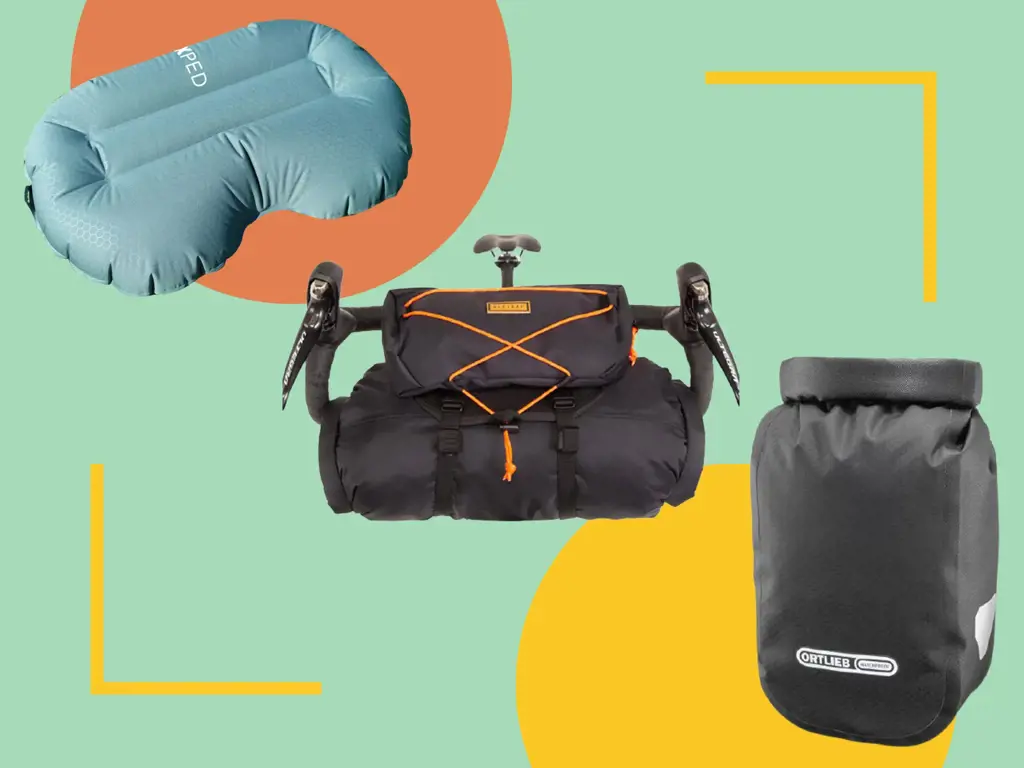
When planning a bikepacking trip, it is important to consider the type of gear you will need to bring with you, including a sleeping bag and tent. These two items are essential for providing shelter and warmth during your overnight stays. In this article, we will discuss what type of sleeping bag and tent you should bring for bikepacking.
Choosing the right sleeping bag is crucial for a comfortable night's sleep while bikepacking. There are three main factors to consider when selecting a sleeping bag: temperature rating, weight, and packability.
- Temperature Rating: The temperature rating of a sleeping bag indicates the lowest temperature at which the bag will keep you warm. It is essential to choose a bag with a temperature rating appropriate for the conditions you expect to encounter during your trip. If you are bikepacking in cold weather, opt for a sleeping bag with a lower temperature rating to ensure you stay warm at night.
- Weight: Since bikepacking involves carrying all your gear on your bike, it is important to minimize weight where possible. Look for a lightweight sleeping bag that won't add unnecessary weight to your load. Down sleeping bags are known for their lightweight and compressibility, making them a popular choice among bikepackers.
- Packability: Packability refers to how small a sleeping bag can be compressed for easy storage and transport. Look for a sleeping bag that can be compressed into a small stuff sack, as this will help you save space in your bikepacking bags.
In addition to a sleeping bag, you will also need a tent for bikepacking. Just like with sleeping bags, there are several factors to consider when selecting a tent:
- Weight: Similar to sleeping bags, choose a lightweight tent to keep your overall gear weight down. Look for a tent made with lightweight materials, such as silnylon or Cuben fiber.
- Packability: Consider how compact the tent is when packed away. Ideally, you want a tent that can be easily stowed away in your bikepacking bags without taking up too much space.
- Durability: Bikepacking often involves rough terrain and unpredictable weather conditions. Choose a tent that is built to withstand these conditions. Look for features such as sturdy poles, reinforced seams, and waterproof materials.
- Size: Consider the size of the tent and how many people it can accommodate. If you are travelling solo, a one-person tent will be sufficient. However, if you are bikepacking with a partner, consider a two-person tent for added comfort and space.
When it comes to specific brands and models, there are many options available that cater to bikepacking specifically. Some popular brands include Big Agnes, MSR, Nemo, and REI. Research different brands and models to find one that best suits your needs and preferences.
To give you a better idea of what to expect, let's look at an example setup. For a bikepacking trip in mild weather, you might choose a sleeping bag with a temperature rating between 30-40 degrees Fahrenheit. Consider a lightweight down sleeping bag that weighs around 2 pounds and can be compressed into a small stuff sack. For the tent, look for a lightweight option that weighs around 3-4 pounds and can comfortably accommodate one or two people. Ensure the tent is durable and easy to set up.
In conclusion, when planning a bikepacking trip, it is important to choose the right sleeping bag and tent. Consider factors such as temperature rating, weight, packability, durability, and size when selecting these items. Research different brands and models to find ones that suit your needs and preferences. With the right gear, you can enjoy a comfortable and restful night's sleep while bikepacking.
Essential Items to Pack for Female Travelers Visiting Peru
You may want to see also

Are there any specific clothing items I should pack for a bike packing trip?
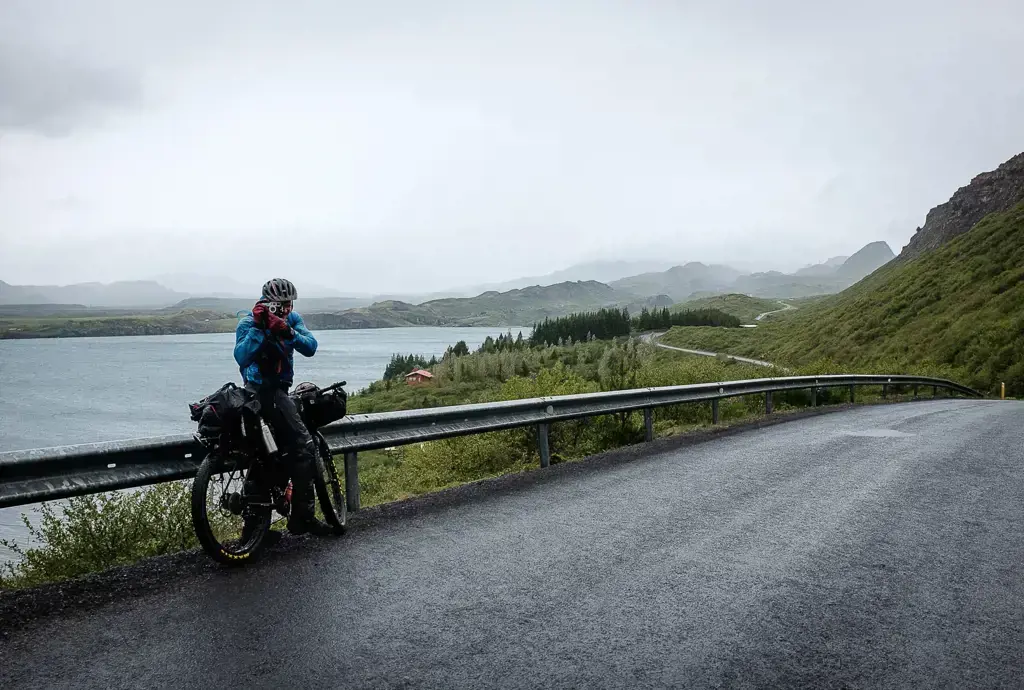
When going on a bike packing trip, it's important to pack the right clothing items to ensure comfort and protection during your adventure. The combination of physical exertion and exposure to the elements can make clothing choices crucial for a successful trip. Here are some specific clothing items you should consider packing for your bike packing trip:
- Cycling Jersey: A cycling jersey is designed to be lightweight, breathable, and moisture-wicking. It helps regulate your body temperature and keeps you dry and comfortable while riding. Look for a cycling jersey with a full or half zip for better ventilation.
- Cycling Shorts: Cycling shorts are padded to provide additional comfort during long rides. They also have a snug fit to reduce friction and prevent chafing. Opt for shorts with moisture-wicking properties to keep you dry and comfortable during your trip.
- Base Layers: Base layers are thin, insulating garments that can be worn under your jersey. They help regulate your body temperature by wicking moisture away from your skin. Look for base layers made from lightweight and breathable materials such as merino wool or synthetic fabrics.
- Cycling Socks: Invest in a good pair of cycling socks that are moisture-wicking and provide cushioning to prevent blisters. Choose socks that are specifically designed for cycling to ensure a better fit and performance.
- Rain Jacket: Weather conditions can change quickly during a bike packing trip, so it's essential to pack a lightweight and waterproof rain jacket. Look for a jacket that is breathable to prevent overheating while still providing protection from rain or wind.
- Arm and Leg Warmers: Arm and leg warmers are versatile clothing accessories that can be easily rolled up and stored in your pack when not needed. They provide additional warmth during chilly mornings or evenings, and you can easily remove them as the temperature rises.
- Gloves: Cycling gloves protect your hands from numbness, vibrations, and blisters. Look for gloves with padding and a breathable design. Consider packing both long-fingered and short-fingered gloves to accommodate different weather conditions.
- Helmet: Safety should always be a top priority when riding a bike. Pack a well-fitting helmet that meets safety standards and provides adequate ventilation.
- Sunglasses: Protecting your eyes from the sun, wind, dust, and insects is crucial when cycling. Invest in a pair of sunglasses with UV protection and a wrap-around design to provide optimal coverage.
- Cycling Shoes: Choose cycling shoes that are compatible with your pedal system and provide good support for your feet. Consider whether you prefer road or mountain bike-style shoes depending on your bike packing trip's terrain.
Remember to pack enough clothing for the duration of your trip. It's also a good idea to have a spare set of cycling clothes in case of unexpected weather changes or accidents. Additionally, you may want to pack casual clothing for off-bike activities and comfortable sleepwear for overnight stays.
By packing the right clothing items for your bike packing trip, you can ensure maximum comfort, protection, and enjoyment during your adventure on two wheels.
Battle Cry: Choosing the Best Pack for Your Needs
You may want to see also

What are some important tools and repair items to bring for bike packing?
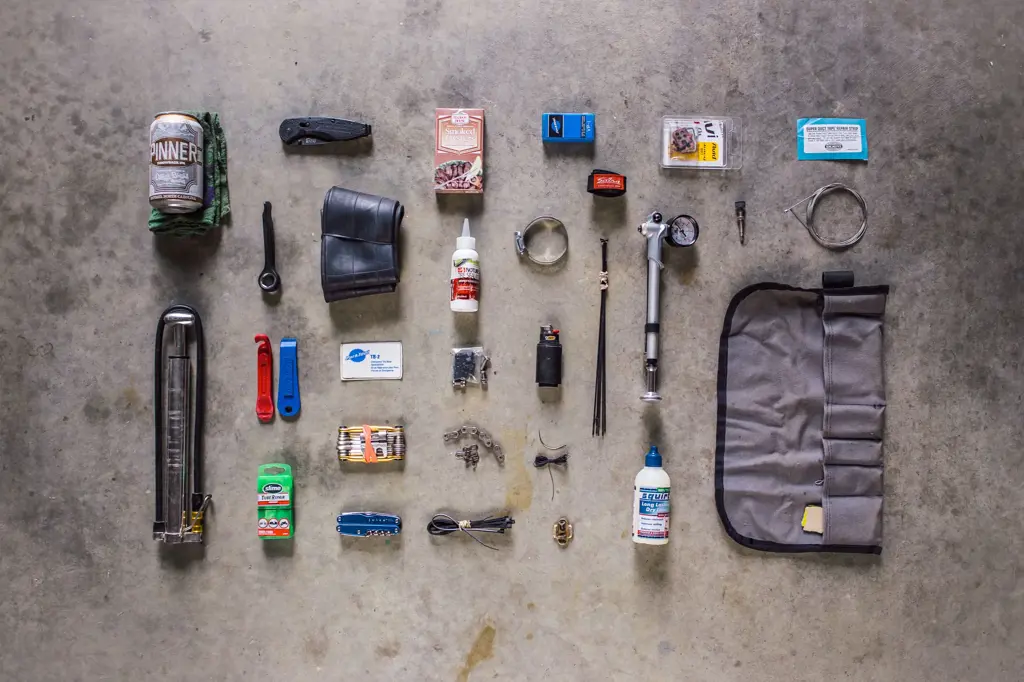
When embarking on a bikepacking adventure, it's essential to be prepared for any potential mechanical issues that may arise along the way. Bringing the right tools and repair items can save you from being stranded in the middle of nowhere. Here are some important tools and repair items to pack for your bikepacking trip.
- Multi-tool: A good quality multi-tool is a must-have item for any bikepacker. It typically includes a variety of Allen wrenches, screwdrivers, and even a chain tool. This compact tool can help you adjust your bike's components and fix minor issues on the go.
- Spare tubes and patches: Flat tires are a common occurrence when bikepacking, so it's crucial to carry spare tubes and patches. Make sure you have the correct tube size for your bike and bring extra patches to fix multiple punctures if needed.
- Tire levers: While it's possible to remove a tire without tire levers, these small tools make the process much easier and faster. Look for lightweight and durable tire levers that won't take up much space in your pack.
- Pump or CO2 inflator: Having a reliable method to inflate your tires is essential. A compact hand pump or a CO2 inflator can come in handy when you need to fix a flat tire quickly. CO2 inflators are lightweight and offer fast inflation, but make sure to carry extra cartridges.
- Chain lubricant: Keeping your bike's chain properly lubricated is crucial for smooth shifting and reducing wear. Packing a small bottle of chain lubricant can help you maintain optimal performance throughout your trip.
- Brake and shifter cables: Over time, cables can stretch or break, which can affect your bike's braking and shifting performance. Bringing a spare set of brake and shifter cables can save you from any major issues. It's also a good idea to pack cable housing and cable end caps.
- Zip ties and duct tape: These versatile items can be a lifesaver in many situations. Use zip ties to secure loose components or temporarily fix broken parts. Duct tape can be used to patch up a torn bag, brace a cracked frame, or even fashion a makeshift tool.
- Spare bolts and nuts: Small bolts and nuts can come loose or get lost during a long ride. Having a few spare ones in different sizes can save the day. A small assortment kit with various sizes can be a great addition to your bikepacking toolkit.
- Chain quick-link or master link: If your bike's chain breaks, having a chain quick-link or master link can make the repair process much easier. Make sure to bring the right size for your chain.
- Spoke wrench: Broken spokes happen, especially when riding on rough terrain with a heavily loaded bike. A spoke wrench allows you to adjust or replace broken spokes, preventing further damages to your wheel.
Remember, prevention is key when it comes to bikepacking. Regularly maintaining your bike before embarking on a trip can help prevent some mechanical issues. Familiarize yourself with basic bike repairs and practice fixing common problems before hitting the trail. Being prepared with the right tools and repair items will ensure a more enjoyable and trouble-free bikepacking adventure.
Essential Items to Pack for Your Trip to Vietnam
You may want to see also
Frequently asked questions
When bike packing, it's important to bring a few essentials. These include a tent or hammock for sleeping, a sleeping bag and sleeping pad for comfort, a stove and cooking utensils to prepare meals, a water filter or purification tablets to ensure safe drinking water, and a repair kit for any bike maintenance needs. Additionally, don't forget to pack food, water, and clothing appropriate for the weather conditions you'll be riding in.
When deciding how much clothing to bring for bike packing, it's important to consider the duration of your trip and the weather conditions you'll be riding in. As a general guideline, you'll want to bring a few changes of cycling shorts and jerseys, a waterproof or windproof jacket, a warm layer for cooler temperatures, a hat and gloves for colder weather, and a set of lightweight clothes for off-bike activities. It's also a good idea to include extra socks and underwear.
Essential gear and equipment for bike packing include a reliable bike with appropriate tires for the terrain you'll be riding on, bike-specific bags or panniers to carry your gear, and a handlebar bag or frame bag for easy access to items like snacks and water. Other important gear includes a helmet, bike lights for safety, a GPS device or maps for navigation, and a bike lock for security when leaving your bike unattended. It's also helpful to have a basic tool kit for bike repairs and maintenance on the go.
When packing gear for bike packing, it's important to distribute weight evenly and securely on your bike. Start by placing heavier items, such as your sleeping bag and cooking equipment, in the bottom of your panniers to help stabilize your bike. Pack clothes and other lighter items on top, making sure to use compression sacks or stuff sacks to minimize the size of your load. Use straps or bungee cords to secure any additional items, like a tent or sleeping pad, to the outside of your bags.
Safety should be a top priority when bike packing. Start by checking the weather forecast before you leave and be prepared for changing conditions. Always wear a helmet and use bike lights when riding in low light or at night. Stay visible to drivers by wearing brightly colored clothing and using reflective accessories. It's also important to let someone know your travel plans and expected routes in case of emergencies. Finally, familiarize yourself with local laws and regulations, and be mindful of traffic and road conditions at all times.





